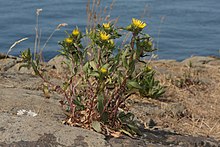Grindelia
| Gumweeds | |
|---|---|

| |
| Puget Sound gumweed (Grindelia integrifolia) | |
| Scientific classification | |
| Kingdom: | Plantae |
| Clade: | Tracheophytes |
| Clade: | Angiosperms |
| Clade: | Eudicots |
| Clade: | Asterids |
| Order: | Asterales |
| Family: | Asteraceae |
| Subfamily: | Asteroideae |
| Supertribe: | Asterodae |
| Tribe: | Astereae |
| Genus: | Grindelia Willd. 1807 |
| Type species | |
| Grindelia inuloides Willd. 1807
| |
| Synonyms[1] | |
| |
Grindelia (gumweed) is a genus of plants native to the Americas belonging to the sunflower family.[2][3][4] The genus was named for Latvian botanist David Hieronymus Grindel, 1776–1836.[5]
They are herbaceous plants or subshrubs with annual, biennial, or perennial life cycles.[5] The flowerheads are composed of numerous yellow disc florets (usually between 100–200) and from zero to sixty or more yellow or orange ray florets.[5] Grindelia squarrosa, a plant with bright yellow flowers indigenous to much of the United States, is commonly called curlycup gumweed. Grindelia robusta, found in the western states, is a coastal scrub bush that is reputed to have several medicinal uses. Hairy gumweed, , occurs in brackish coastal marshes of western North America, such as in some portions of the San Francisco Bay perimeter.[5] The genus is native to South America, Mexico, and western North America, though some species have been introduced and naturalized in eastern North America and the Old World.[5]
Grindelia species are used as food plants by the larvae of some Lepidoptera species including Schinia mortua.
Species[]
There are many species,[5] including:[1][6][7][8][9]
- Grindelia adenodonta - Texas
- - Buenos Aires
- Grindelia aggregata - British Columbia
- - Chile
- - Chile, Argentina
- Grindelia arizonica - USA (Arizona New Mexico Utah Colorado), Coahuila, Chihuahua, western Texas
- - Bolivia, Peru, Argentina
- - Peru, Argentina
- Grindelia buphthalmoides - Uruguay, Rio Grande do Sul, Buenos Aires
- - northern Argentina
- - northern Argentina, Paraguay
- - Chile, Argentina
- Grindelia ciliata - western + central USA
- Grindelia confusa - Chihuahua
- - southern Argentina
- - northern Argentina
- Grindelia decumbens - Colorado, New Mexico
- - Nuevo León, Coahuila, Chihuahua
- Grindelia fraxinipratensis - California, Nevada
- - northern Argentina
- - Tarapacá, Peru
- Grindelia grandiflora - Coahuila, Texas
- Grindelia greenmanii - Nuevo León, Coahuila, San Luis Potosí
- Grindelia havardii - Texas, New Mexico
- Grindelia hintoniorum - Nuevo León
- Grindelia hirsutula - California
- Grindelia howellii - Idaho
- Grindelia integrifolia - Oregon Washington British Columbia
- Grindelia inuloides - from Coahuila to Oaxaca
- Grindelia lanceolata - USA (mostly southern Plains), Nuevo León
- - Uruguay
- Grindelia macvaughii - Jalisco
- - northern Argentina
- Grindelia microcephala - Texas
- Grindelia nelsonii - Jalisco, Colima, Michoacán
- Grindelia nuda - Colorado, New Mexico, Texas, Oklahoma
- Grindelia oaxacana - Oaxaca
- Grindelia obovatifolia - Nuevo León
- Grindelia oolepis - Texas
- - Uruguay
- Grindelia oxylepis - New Mexico, Chihuahua, Coahuila, Durango, San Luis Potosí, Colima
- Grindelia palmeri - San Luis Potosí
- - Argentina
- - northern Argentina
- - Chile, southern Argentina
- - Rio Grande do Sul, Argentina, Paraguay
- Grindelia pusilla - Texas, Coahuila
- - southern Argentina
- - northern Argentina
- Grindelia robinsonii - San Luis Potosí, Hidalgo
- Grindelia robusta - California, Baja California, Baja California Sur
- - Rio Grande do Sul, Uruguay
- Grindelia scabra - Texas, New Mexico, Coahuila
- - Argentina, Paraguay, Brazil, Uruguay
- Grindelia squarrosa - much of USA + Canada
- Grindelia stricta - west coast of North America (California to Alaska)
- Grindelia subalpina - Colorado, New Mexico, Wyoming
- Grindelia subdecurrens - San Luis Potosí, Zacatecas, Aguascalientes
- Grindelia sublanuginosa - Jalisco
- - Tarapacá, Peru
- - Argentina
- Grindelia tenella - Nuevo León, San Luis Potosí, Tamaulipas
- Grindelia turneri - Nuevo León
- Buenos Aires
- Grindelia vetimontis - Nuevo León
- - Nuevo León
References[]
- ^ a b Flann, C (ed) 2009+ Global Compositae Checklist
- ^ Willdenow, Carl Ludwig von. 1807. Magazin für die Neuesten Entdeckungen in der Gesammten Naturkunde, Gesellschaft Naturforschender Freunde zu Berlin 1(4): 259–261
- ^ "Grindelia Willd.". Tropicos. Missouri Botanical Garden.
- ^ Nesom, Guy L. 1990. Studies in the systematics of Mexican and Texan Grindelia (Asteraceae: Astereae). Phytologia 68(4):303-332
- ^ a b c d e f Strother, John L.; Wetter, Mark A. (2006). "Grindelia". In Flora of North America Editorial Committee (ed.). Flora of North America North of Mexico (FNA). Vol. 20. New York and Oxford – via eFloras.org, Missouri Botanical Garden, St. Louis, MO & Harvard University Herbaria, Cambridge, MA.
- ^ "Grindelia". County-level distribution maps from the North American Plant Atlas (NAPA). Biota of North America Program (BONAP). 2013.
- ^ Davidse, G., M. Sousa-Peña, S. Knapp & F. Chiang Cabrera. 2015. Asteraceae. 5(2): ined. In G. Davidse, M. Sousa Sánchez, S. Knapp & F. Chiang Cabrera (eds.) Flora Mesoamericana. Universidad Nacional Autónoma de México, México
- ^ Pruski, J.F. & G. Sancho. 2004. Asteraceae or Compositae (Aster or Sunflower Family). 33–39. In N. Smith & et al. (eds.) Flowering plants of the Neotropics. Princeton University Press, Princeton.
- ^ The Plant List, search for Grindelia
External links[]
- Grindelia
- Asteraceae genera